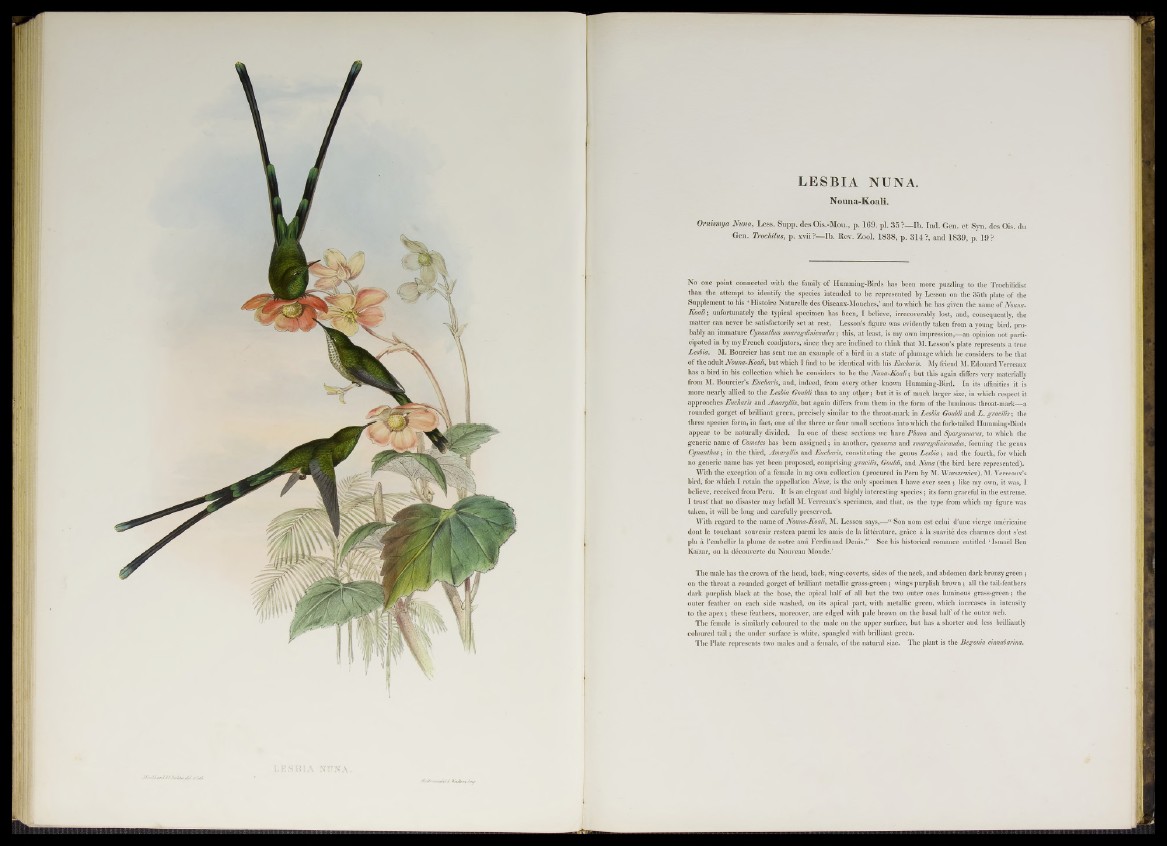
LESBIA NUNA.
Nouna-Koali.
O rn imya Nuna, Less. Supp. des Ois.-Mou., p. 169. pl. 35 ?—Ib. Ind. Gen. et Syn. des Ois. du
Gen. Trochilus, p. xvii?—Ib. Eev. Zool. 1838, p. 314?, and 1839, p. 19?
No one point connected with the family of Humming-Birds has been more puzzling to the Trochilidist
than the attempt to identify the species intended to be represented by Lesson on the 35th plate of the
Supplement to his ‘Histoire Naturelle des Oiseaux-Mouches,’ and to which he has given the name of Nouna-
Koali ; unfortunately the typical specimen has been, I believe, irrecoverably lost, and, consequently, the
matter can never be satisfactorily set at rest. Lesson’s figure was evidently taken from a young bird, probably
an immature Cynanthus smaragdinicaudus ; this, at least, is my own impression,—an opinion not participated
in by my French coadjutors, since they are inclined to think that M. Lesson’s plate represents a true
Lesbia. M. Bourcier has sent me an example of a bird in a state of plumage which he considers to be that
of the adult Nouna-Koali, but which I find to be ideutical with his Eucharis. My friend M. Edouard Verreaux
has a bird in his collection which he considers to be the Nuna-Koali‘, but this again differs very materially
from M. Bourcier’s Eucharis, and, indeed, from every other known Humming-Bird. In its affinities it is
more nearly allied to the Lesbia Gouldi than to any other ; but it is of much larger size, in which respect it
approaches Eucharis and Amaryllis, but again differs from them in the form of the luminous throat-mark—a
rounded gorget of brilliant green, precisely similar to the throat-mark in Lesbia Gouldi and L. gracilis ; the
three species form, in fact, one of the three or four small sections into which the fork-tailed Humming-Birds
appear to be naturally divided. In one of these sections we have Phaon and Sparganurus, to which the
generic name of Cometes has been assigned ; in another, cyanurus and smaragdinicaudus, forming the genus
Cynanthus ; in the third, Amaryllis and Eucharis, constituting the genus Lesbia ; and the fourth, for which
no generic name has yet been proposed, comprising gracilis, Gouldi, and Nuna (the bird here represented).
With the exception of a female in my own collection (procured in Peru by M. Warszewicz), M. Verreaux’s
bird, for which I retain the appellation Nuna, is the only specimen I have ever seen ; like my own, it was, I
believe, received from Peru. It is an elegant and highly interesting species ; its form graceful in the extreme.
I trust" that no disaster may befall M. Verreaux’s specimen, and that, as the type from which my figure was
taken, it will be long and carefully preserved.
With regard to the name of Nouna-Koali, M. Lesson says,—“ Son nom est celui d’une vierge américaine
dont le touchant souvenir restera parmi les amis de la littérature, grâce à la suavité des charmes dont s’est
plu à l’embellir la plume de notre ami Ferdinand Denis.” See his historical romance entitled ‘ Ismaël Ben
Kaïzar, ou la découverte du Nouveau Monde.’
The male has the crown of the head, back, wing-coverts, sides of the neck, and abdomen dark bronzy green ;
on the throat a rounded gorget of brilliant metallic grass-green ; wings purplish brown ; all the tail-feathers
dark purplish black at the base, the apical half of all but the two outer ones luminous grass-green ; the
outer feather on each side washed, on its apical part, with metallic green, which increases in intensity
to the apex ; these feathers, moreover, are edged with pale brown on the basal half of the outer web.
The female is similarly coloured to the male on the upper surface, but has a shorter and less brilliantly
coloured tail ; the under surface is white, spangled with brilliant green.
The Plate represents two males and a female, of the natural size. The plant is the Begonia cinnabarina.